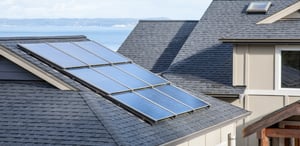 Which is the more cost-effective method of reaching energy code requirements, saving energy or generating it with solar panels on-site? According to a new report, the answer is clear.
Which is the more cost-effective method of reaching energy code requirements, saving energy or generating it with solar panels on-site? According to a new report, the answer is clear.
Renewable energy in the form of solar photovoltaic panels is a relatively new addition to residential building energy codes, but the use of the technology has expanded significantly in recent years. A new report from the American Council for an Energy-Efficient Economy (ACEEE) concludes that despite the popularity of solar to meet energy code requirements, “energy efficiency is the more cost-effective option in new home construction to achieve levels of efficiency associated with minimal energy code requirements.”
The goal of the white paper is to provide economic and technical guidance to energy code policymakers and states as they adopt and amend efficiency and renewable energy measures in building energy codes. While the report acknowledges that both energy efficiency and solar PV have advantages for homeowners, it expresses concern that using onsite PV to achieve compliance with model energy codes could result in buildings with reduced envelope efficiency with no additional carbon reductions.
Energy Generated vs. Energy (and Costs) Saved
Homes consume 42 percent of all energy, with heating and cooling accounting for more than 40 percent of a home’s energy use. Building energy efficiency codes should strive first and foremost to ensure that the building envelope is constructed in a manner that ensures that energy consumption for heating and cooling is as efficient as possible. In fact, the largest energy efficiency gains occurred in back-to-back editions of the International Energy Conservation Code (IECC) in 2009 and 2019, which together achieved a 32 percent energy savings compared to the 2006 IECC.
The 2015 IECC introduced the Energy Ratings Index (ERI) as an optional compliance path. The ERI path gives credit for onsite renewable generation and is modeled after RESNET’s HERS Score. Some advocates interpreted the ERI’s connection to HERS to suggest that onsite renewable generation could be used in place of energy efficiency measures to meet ERI targets – such as installing solar PV panels instead of higher R-value insulation. Others determined renewables would be excluded from the ERI, with some states, like Texas, explicitly prohibiting the use of renewable energy for code compliance under the ERI.
The option to allow a one-for-one trade-off between solar and building efficiency is based on the idea that the value of a kilowatt hour of energy saved is the same as the value of a kilowatt hour generated, which this study’s analysis proves incorrect.
The study evaluated the amortized costs of increased energy efficiency measures of the 2009-2015 IECC and rooftop solar in St. Louis and on a national level and found that energy efficiency is more cost-effective than rooftop solar generation. Whereas energy efficiency saves consumers $4-$32 per month, solar generation adds a payment of up to $14 per month for homeowners, thus leading to the conclusion that “across the board, energy efficiency is more cost-effective than rooftop solar generation.”
But There’s More
Aside from the financial and energy savings benefits, there are many other advantages of prioritizing building envelope efficiency, as noted in the report. Among those benefits are reduced greenhouse gas emissions and air pollution; the increased building resilience of a well-insulated home; lowering the peak energy demand to the grid by having a home that requires less energy to heat and cool; and increasing the health and comfort of building occupants.
Conclusion
While renewable energy generation is an evolution in building technology that has its advantages, onsite renewable energy generation through solar PV can’t supplant the overwhelming benefits and gains achieved through energy-efficient envelope construction and technologies. As policymakers consider the development and adoption of new building energy codes, they would be wise to remember the science and data overwhelmingly supports maintaining a strong building envelope.





